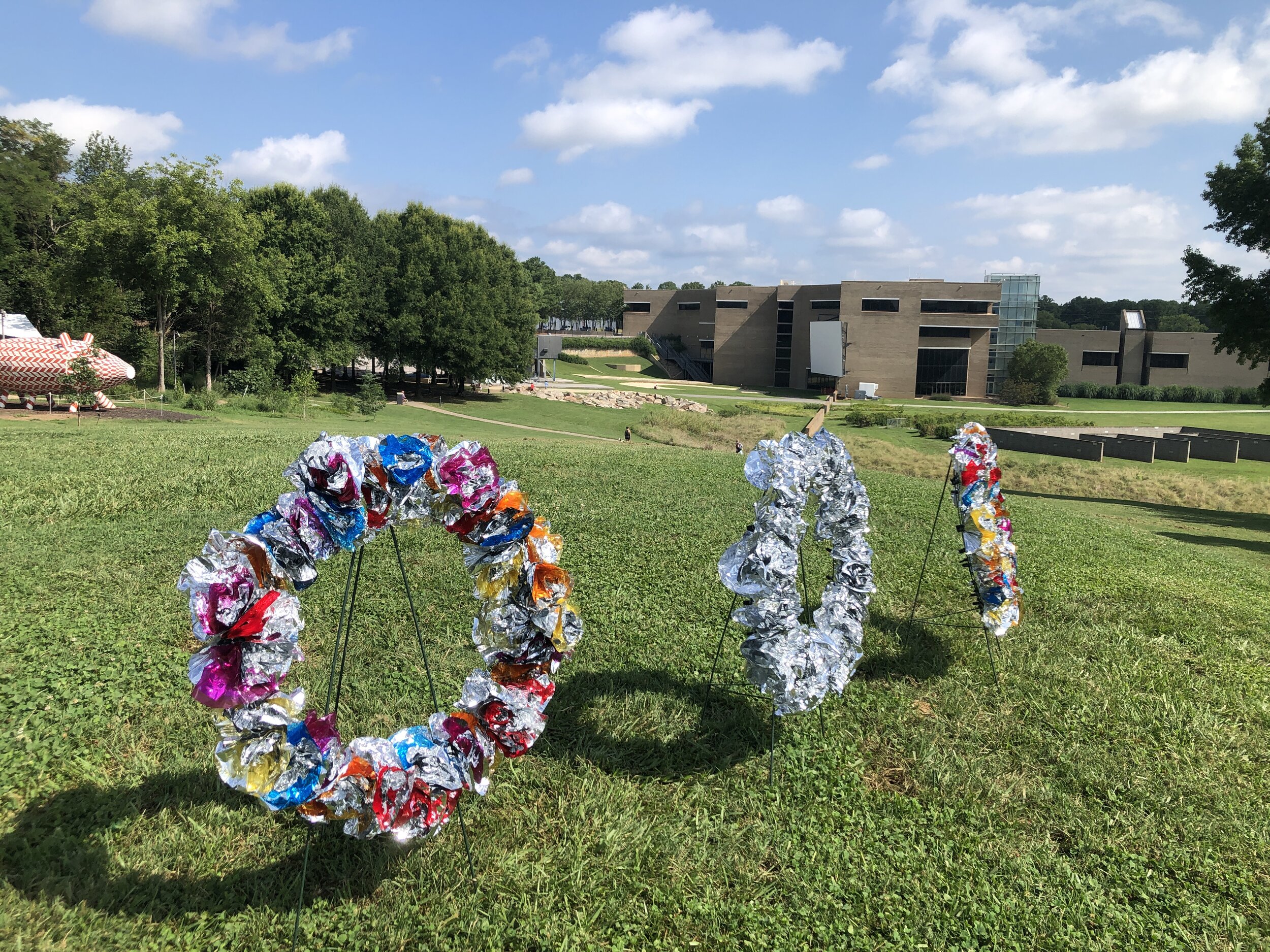VITAL Diary: Pivoting with art in times of crisis
A test run of VITAL Health wreaths for a future installation in the NC Museum of Art Park, Raleigh, NC. Photo by Stacey L. Kirby.
When we decided to begin Phase 1 of VITAL Health in April of 2020, we knew that a pandemic was taking hold around the world and moving quickly into the United States. Our response was to dive into this project in hopes of helping other people throughout our communities as we also grappled with our own responses to the “new normal.” We began a series of flower-making workshops with guest co-facilitator Kelsey Evans-Amalu, PhD (based in Orlando, Florida) to offer a combination of mental health coping strategies and simple therapeutic art-making.
Once we set our first three workshop dates and participants were registering in Eventbrite, I dove quickly into cutting materials and mailing packets to participants. [VITAL Health number: I hand cut 3000+ squares (10”x10”) of silver thermal mylar material and multicolored cellophane in less than a month. Thank goodness for podcasts.] However, given that we have never experienced a pandemic in our lifetime, we have literally been moving through this project in real-time and making adjustments as changes were necessary. (We actually had to shoot website photography for this project during strict social distancing and “stay-at-home” orders. Hence why we have no groups of people participating in our earlier images, which is odd as this project is truly about community.)
What became very clear to us is that the project has taken on a life of its own.
On May 25, 2020, George Floyd was unjustly murdered by a Minneapolis police officer — three days prior to our first VITAL Health workshop with the community. To be honest, the three of us were not preparing to speak to workshop participants about the recent killing. We were reviewing and discussing our slides prepared days before about mental health coping strategies. I was anxiously reorganizing materials for my first virtual flower-making demonstration. I recall feeling a deep sense of internal reflection as we were moving through our workshop. Plus, we were all processing the recent violence and uprising while also still in the midst of a pandemic. As we know, unfortunately, violent deaths of Black individuals at the hands of police officers is not new. We also know that health inequities (in addition to many others) for BIPOC in the United States is also not new. However, we could not have anticipated the intersection of a pandemic with historical inequities leading to such escalating violence and death — at the hands of the police and COVID-19.
During Phase 1 for VITAL Health, we continued holding our workshops as we watched the protests, demonstrations and research in real-time reveal that the Black and Brown communities are suffering and dying from COVID-19 at alarming rates in relation to whites. Michael, Kelsey and I made adjustments in our facilitation of workshops to acknowledge the unfolding of this “new normal.” I hear myself encouraging people to reach out to their mental health support system and resources yet also reflecting that we are NOT all in the same boat in this pandemic. Yes, we are in a shared body of water. But our boats are not the same. Neither is our safety equipment (aka life jackets). Nor is the type or size of boat. Some people are literally treading water — but only if they have actually been taught how to tread water at all. This, too, is a privilege.
If you are not aware of the inequities in access to resources, then now is the time to educate yourself. No, a virus may not discriminate. But without access to the necessary resources and healthcare, the chance of contracting and dying from COVID-19 is much greater — specifically for BIPOC in the United States.
As we move into Phase 2 of VITAL Health, Michael and I have agreed that a next round of workshops with a shift of focus is extremely important and necessary to the work. The two of us will be broadcasting live via Zoom (six feet apart, of course) from the North Carolina Museum of Art, our newest partner on the VITAL Health project. We are inviting trauma therapist Simone Jacobs into the virtual conversation as well as our collaborators Johnny Lee Chapman, III and Anthony Otto Nelson, Jr. During these workshops, we will be diving into the effects of trauma on our mental health and the social unrest in relation to COVID-19. We are also excited to share a sneak peek of the trailer for “Crisis Materials,”’ a video piece filmed near Dix Cemetery with movement by Nelson and poetry by Chapman.
Masked and more than six feet apart in the NC Museum of Art auditorium, Michael and I worked with staff on technology needs for broadcasting on site for upcoming workshops.
We will still create art to bring beauty and potential joy into participants’ homes. But for this next round of flower-making, we’ll be creating flowers as a reminder of our mental health strategies but also to honor those who have come before us and those that will come after that are part of this unfolding racial and public health crisis. We will be asking that a portion of the flowers made by participants be donated to the VITAL Health. The North Carolina Museum of Art will be a drop-off location (or can be mailed if located at a further distance). We will use the collected flowers from participants to form wreaths that will be featured in the upcoming installation in the NCMA Park in October and November as well as future live performances (2021) with our collaborators.
We are looking forward to Phase 2 and hope that you will join us.



